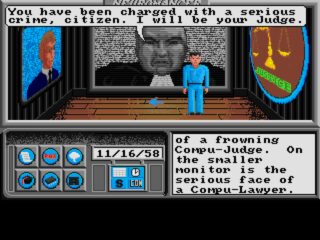
Author: GN Team - Published: 2 November 2018, 9:44 pm
Neuromancer is a graphic adventure created for the C64 by Interplay, loosely based on the cyberpunk novel by William Gibson.
The game was programmed and designed by Troy A. Miles with the help of other famous names such as Michael A. Stackpole (Wasteland, Star Trek: 25th Anniversary, The Bard's Tale III) and Brian Fargo, founder of Interplay.
The writers made an excellent job creating a story set in the same universe of the sci-fi novel, but different enough to make it interesting for the ones that already know the book. You will have the chance to visit Chiba City and meet several characters created by Gibson. Cyberspace combat and database hacking are also part of the game. In addition to the more traditional adventure mode, Neuromancer has a 3D grid representation of the cyberspace. Not mentioning some RPG elements, like "skill chips" that can be used to improve the main character's skills.
Read More
Author: GN Team - Published: 20 October 2018, 1:02 am
Midwinter is a first-person action-adventure game with strategy elements created by Mike Singleton for Maelstrom Games. It was published for Atari ST and PC in 1989 and later ported to Amiga in 1990.
The game is set in a post-apocalyptic world entirely covered by snow. The player initially controls Captain John Stark (a future Stark from Winterfell?), who has to protect the island of Midwinter from the invasion of the evil General Masters' forces. The captain must recruit several people to help him organize a guerrilla army strong enough to stop the enemy.
Read More
Author: GN Team - Published: 11 October 2018, 12:31 am
Switchblade II is an action platformer created by Gremlin Graphics (aka Gremlin Interactive) originally for the Amiga in 1991. It was then ported to Atari ST, Amstrad CPC, and Atari Lynx.
It was the sequel to Switchblade, a game released 2 years before, initially developed by Simon Phipps for the Atari ST. This futuristic shoot 'em up is clearly inspired by Japanese arcade games, with excellent graphics, vivid colors, and manga-style characters. The animations of the enemies and the backgrounds are simply amazing. The movements of the character are fluid and the playability is great. Compared to the original Switchblade, this sequel has bigger sprites, larger levels, and more weapons. It also uses 32 colors on the Amiga, while the Atari ST version only has 16.
Read More
Author: GN Team - Published: 29 September 2018, 11:54 pm
Elite is a famous space flight and trading sim created by David Braben and Ian Bell for the BBC Micro. The game was published by Acornsoft and Firebird and released for several home computers starting in 1984.
The development of the game, one of the most influential and innovative titles ever created, started on an Acorn BBC Micro. Bell and Braben developed the game entirely in assembly language to be able to pack all features in the limited memory of this 8-bit computer. Elite featured revolutionary wireframe 3D graphics and open-ended gameplay based on exploration and trading in a procedurally generated universe. The success led to the porting to almost all available platforms, including Commodore 64, ZX Spectrum, PC, Amiga, Atari ST, and NES.
Read More
Author: Tasha - Published: 22 September 2018, 12:46 pm
Star Control II is the sci-fi strategy game sequel to the original Star Control. It was developed by Toys for Bob and published by Accolade in 1992. Initially released for MS-DOS, it was ported to 3DO in 1994.
Designed and programmed by Fred Ford and Paul Reiche III, the sci-fi masterpiece is considered one of the best games ever created for PC.
Star Control II picks up the story from the original where a galactic war still rages between the Alliance of Free Stars and the destructive Hierarchy of Battle Thralls. So far the Battle Thralls have got an edge on the Alliance and has taken Earth as a slave planet. Meanwhile, the Alliance had sent a research crew who wound up stranded on a distant planet after shipping their only ship for help. Ten years later, the stranded team was finally able to complete a vessel to get off the planet with the help of a child prodigy born to a crew member. You take control of the hero as your ship is captured by the enemy. Your goal is to escape your captors, recruit an army of alien allies and save the galaxy. How hard could it be?
Read More
Author: GN Team - Published: 18 September 2018, 1:14 am
Speedball is a video game created by The Bitmap Brothers based on a violent futuristic sport and probably inspired by the 1975 sci-fi movie Rollerball.
Initially developed for Amiga and published in 1988, the game was later ported to Atari ST, Commodore 64, and DOS. A SEGA Master System and an NES version were also released later.
The game is a sort of mix between hockey and five-a-side football. The Bitmap Brothers created an innovative and revolutionary game, considering the time. The music by David Whittaker and the graphics by Mark Coleman (Gods, Xenon 2: Megablast, Interphase) helped a lot, but the fast and furious gameplay is what gamers really appreciated.
Read More